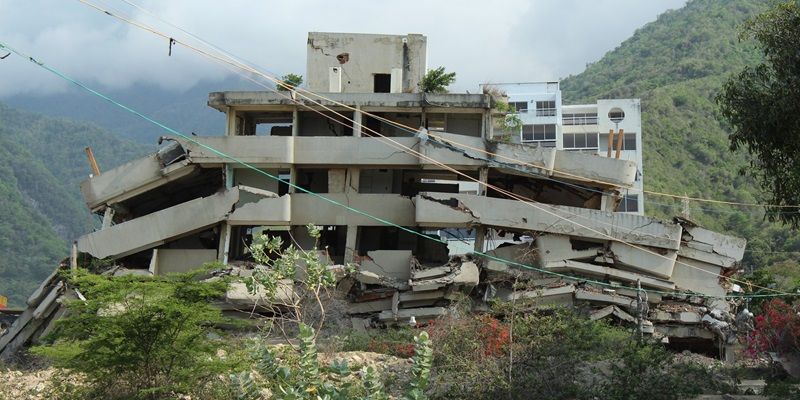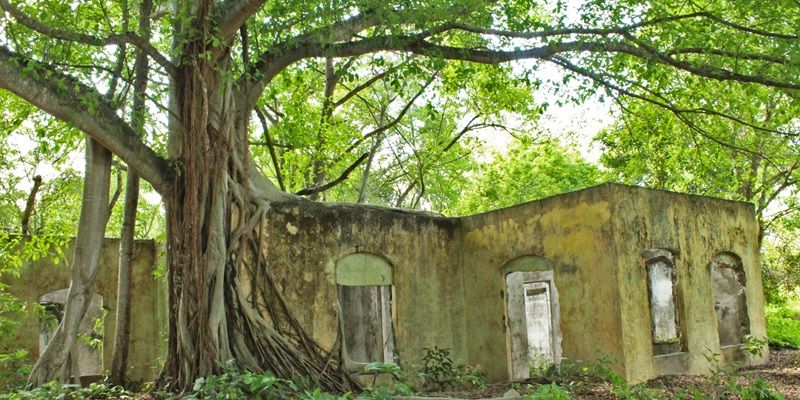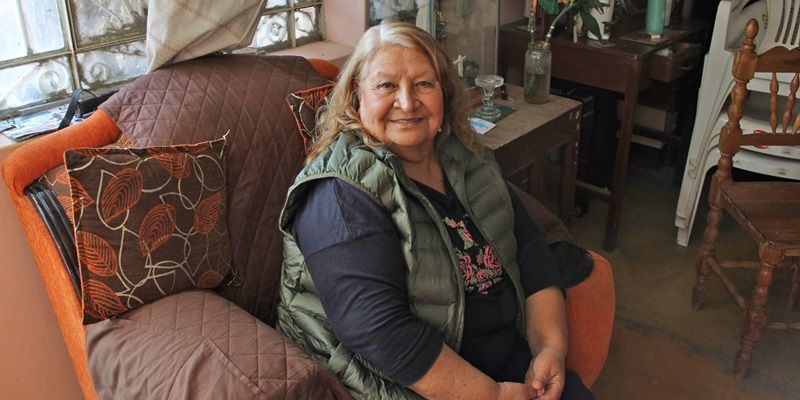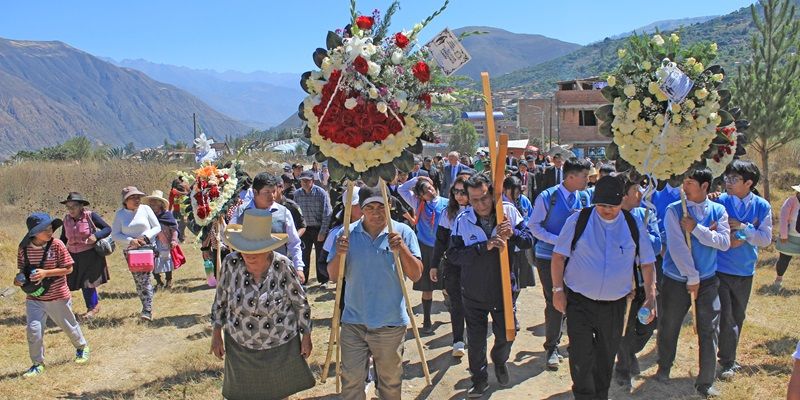Dr Rebecca Jarman, Associate Professor of Latin American Studies at the University of Leeds, is working with communities from around the world that have risen from the ruins of catastrophic landslides.
Vargas, Armero, Yungay, Aberfan: four names that are synonymous with tragedy.
In Aberfan, a village in South Wales, a landslide in 1966 engulfed a primary school, killing 144 people, including 116 children.
Yungay, a town in the Peruvian Andes was almost completely buried by a landslide in 1970, where only 400 of the town's 8,000 inhabitants survived.
In Armero, Colombia, more than 20,000 people died in 1985 when the town was inundated by debris flows, triggered by a volcanic eruption.
And the coastal state of Vargas, in Venezuela, saw 50 separate landslides during a devastating week of heavy rain in December 1999, which destroyed thousands of homes and claimed over 2,000 lives.

A ruined building in Vargas; a reminder of the devastating landslides of 1999 which killed thousands of the town’s inhabitants. Photo credit: Daniel Ceballos Contreras
The Moving Mountains project
During the decades that followed these catastrophes, the communities affected have rebuilt themselves, physically and emotionally. The long-term legacy and impact of such events is what interests Dr Rebecca Jarman, Associate Professor of Latin American Studies at the University of Leeds.
Her research involves working both with survivors and those from later generations who now live in the towns that have risen from the ruins.
“A lot of research tends to focus on the immediate effects of disasters, but I’m particularly interested in the intergenerational effects that you see 10, 20, 50 or 60 years after a landslide has happened,” says Dr Jarman.
“I want to understand how a disaster is memorialised, the recovery strategies that communities put in place, how the disaster is reflected in the arts, such as film and literature, and how the event is seen by the younger generation today.”
Her work – the Moving Mountains project – began in Venezuela, working with survivors there to map the key sites that related to the disaster across the state of Vargas and the how the community had rebuilt them.
The Vargas landslides coincided with the election of the populist Hugo Chávez as president of Venezuela and, as a result, disaster recovery and politics became closely intertwined. Part of Dr Jarman’s research in the area looked at how the disaster was treated in film and literature, and particularly how the arts became a platform to critique some of the disaster recovery policies set out by the Chávez government.
When working in Venezuela became untenable due to the political situation, Dr Jarman’s research moved to Armero, in Colombia. Again, she spoke to survivors, mapped out key areas of the ruined site and the new town, and looked at the role of film, poetry and literature in processing the trauma and political fallout from the disaster for those most intimately affected.
“The way these events are portrayed through contemporary arts show us how the consequences of disasters play out over very long periods of time,” explains Dr Jarman.
“In Armero, it wasn’t the volcanic eruption alone that caused the disaster. The authorities had been warned that an eruption could cause debris to overwhelm a lake and trigger the debris and mud flows that destroyed the town. The risks were known, but nothing was done - and many artists and writers have used their work to question the apathy and inaction of the Colombian state.
This is a common theme across all the sites I studied. Because the state is not always willing to enter into conversation with disaster victims, then those conversations have to happen elsewhere. And the arts are often the place those conversations go to.”
This was the case for Víctor Hernán Cubillos, with whom Dr Jarman has collaborated in her research. He is one of the survivors of a group of geology students from the University of Caldas, who were in Armero for the final night of their field trip when disaster struck.
In the face of indifference from the Colombian government and a lack of a proper memorial at the site itself, Victor recorded his memories in a book – No íbamos para Armero (We're not going to Armero), in poetry and in songs to create a tangible testimonial. Victor believes his openness in talking about his experience of the disaster has also helped him to process the trauma on a personal level.
“A few months after the disaster, when the surviving students were out of hospital and back at university, they brought in a therapist to see us,” recalls Vìctor. “He told us to speak about the experience and our memories, and not keep things closed up inside, and I took his words to heart.
Unfortunately, most of the group didn't follow that advice and many of them are still suffering emotional crises, even 40 years on.”

In Almero, where a volcanic eruption created a chain reaction of deadly events, many artists and writers have used their work to question the Colombian state’s failure to act on known risks. Photo credit: Rebecca Jarman
Dr Jarman’s research in Vargas and Armero was funded through various small grants, but in 2021, she was awarded a fellowship from the Arts and Humanities Research Council, part of UK Research and Innovation, which enabled her to work in more depth with communities in the two other locations of the Moving Mountains project: Aberfan and Yungay.
Once again, Dr Jarman interviewed survivors and mapped important sites relating to the disasters. She’s also run workshops in primary schools in both Yungay and Aberfan, looking at these maps with children to understand their perspectives on the past and links to the present. The maps are being shared between the schools in each town, with key words translated into Welsh, English, Spanish and Quechua to give the children a language learning opportunity as well.
In Yungay, Dr Jarman has also partnered with the Peruvian University of Applied Sciences (UPC), bringing journalism students from the capital to Yungay to make a documentary and write a chronicle about the events of 1970.
One of the survivors who has been interviewed by the students for the document is Deysi Mori, who was 14 years old when the landslide struck on May 31, 1970.
She saved herself, along with her brothers and sisters, by running to the cemetery, which sits on higher ground overlooking the town, and was stranded there for several days before being rescued. Her parents did not survive the landslide.

Deysi Mori, who was a teenager when her hometown was engulfed in a landslide, finds writing helps her deal with the experience. Photo credit: Daniel Ceballos Contreras
Deysi was then sent to a convent, but as an adult, she chose to return to the new town, which was built right next to the ruins of the old, and make her life there. She is another survivor who has used the arts - in her case, poetry - to help deal with the trauma.
Deysi has also found a benefit from being open about her experience. “I write because through writing, I’ve healed myself psychologically,” says Deysi. “It’s a kind of catharsis, so every time I was in great pain, I would fill my notebooks with writing, writing and writing. Then I turned these thoughts into verse.”
Deysi has also been involved in the most recent part of the Moving Mountains project in Yungay – a fictional film focused on a survivor of the disaster, now in his old age, who is looking back at his memories of losing his parents and wider family.
Dr Jarman is working with a professional production company to make the film and has invited girls from a local secondary school, the Colegio Santo Domingo de Guzmán, to work behind the scenes. The girls interviewed Deysi for background on life in Yungay in the 1960s to flesh out the characters in the film and develop the script.
“We’re going to do a lot of the filming on the memorial site of the ruined town,” says Dr Jarman. “One of the objectives of the film is to try and draw attention to the importance of the memory of this disaster and why for younger generations, it's important too. As fewer survivors remain, all of whom were children themselves at the time, that’s changing how the event is remembered and how the sites are being conserved. Even in the few years we’ve been working in Yungay, we can see these changes happening.”
One of the students involved in the film project, Karla Isabel Ángeles Ángeles, says: “Before working on the film, I don’t think I had met a survivor before. It’s made me understand the story and their view about what happened. I can now explain to my friends, to my colleagues, to my relatives the truth about what Yungay was before and what happened to its inhabitants.
The date of May 31st will always be remembered with pain, but still with hope because we were able to move forward. When the film is ready, it’s going to bring Yungay back into the spotlight and it’s going to inform the new generations again. This will be like a memorial, so that the truth of the history of what happened here can continue to spread.”

Commemorations take place in Yungay, Peru, every year on 31 May. Photo credit: Daniel Ceballos Contreras
This is one of the benefits that the larger research fellowship has enabled, according to Dr Jarman. “We’ve gone from working predominantly with disaster survivors on a one-on-one basis, to working with institutions and with larger groups of young people. This means we can engage with many different facets of the community and ensure that the work that we’re doing also has a positive impact in the area, beyond a relatively small group of disaster survivors, rewarding as that has been.”
Visit Dr Rebecca Jarman’s website.